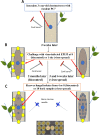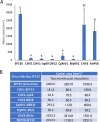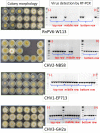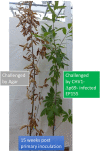In-Tree Behavior of Diverse Viruses Harbored in the Chestnut Blight Fungus, Cryphonectria parasitica
- PMID: 33361433
- PMCID: PMC8094943
- DOI: 10.1128/JVI.01962-20
In-Tree Behavior of Diverse Viruses Harbored in the Chestnut Blight Fungus, Cryphonectria parasitica
Abstract
The ascomycete Cryphonectria parasitica causes destructive chestnut blight. Biological control of the fungus by virus infection (hypovirulence) has been shown to be an effective control strategy against chestnut blight in Europe. To provide biocontrol effects, viruses must be able to induce hypovirulence and spread efficiently in chestnut trees. Field studies using living trees to date have focused on a selected family of viruses called hypoviruses, especially prototypic hypovirus CHV1, but there are now known to be many other viruses that infect C. parasitica Here, we tested seven different viruses for their hypovirulence induction, biocontrol potential, and transmission properties between two vegetatively compatible but molecularly distinguishable fungal strains in trees. The test included cytosolically and mitochondrially replicating viruses with positive-sense single-stranded RNA or double-stranded RNA genomes. The seven viruses showed different in planta behaviors and were classified into four groups. Group I, including CHV1, had great biocontrol potential and could protect trees by efficiently spreading and converting virulent to hypovirulent cankers in the trees. Group II could induce high levels of hypovirulence but showed much smaller biocontrol potential, likely because of inefficient virus transmission. Group III showed poor performance in hypovirulence induction and biocontrol, while efficiently being transmitted in the infected trees. Group IV could induce hypovirulence and spread efficiently but showed poor biocontrol potential. Nuclear and mitochondrial genotyping of fungal isolates obtained from the treated cankers confirmed virus transmission between the two fungal strains in most isolates. These results are discussed in view of dynamic interactions in the tripartite pathosystem.IMPORTANCE The ascomycete Cryphonectria parasitica causes destructive chestnut blight, which is controllable by hypovirulence-conferring viruses infecting the fungus. The tripartite chestnut/C. parasitica/virus pathosystem involves the dynamic interactions of their genetic elements, i.e., virus transmission and lateral transfer of nuclear and mitochondrial genomes between fungal strains via anastomosis occurring in trees. Here, we tested diverse RNA viruses for their hypovirulence induction, biocontrol potential, and transmission properties between two vegetatively compatible but molecularly distinguishable fungal strains in live chestnut trees. The tested viruses, which are different in genome type (single-stranded or double-stranded RNA) and organization, replication site (cytosol or mitochondria), virus form (encapsidated or capsidless) and/or symptomatology, have been unexplored in the aforementioned aspects under controlled conditions. This study showed intriguing different in-tree behaviors of the seven viruses and suggested that to exert significant biocontrol effects, viruses must be able to induce hypovirulence and spread efficiently in the fungus infecting the chestnut trees.
Keywords: Cryphonectria parasitica; chestnut blight fungus; hypovirus; mitovirus; mycovirus; reovirus; virus spread.
Copyright © 2021 American Society for Microbiology.
Figures







Similar articles
-
Biological control of chestnut blight in Croatia: an interaction between host sweet chestnut, its pathogen Cryphonectria parasitica and the biocontrol agent Cryphonectria hypovirus 1.Pest Manag Sci. 2017 Mar;73(3):582-589. doi: 10.1002/ps.4335. Epub 2016 Jul 15. Pest Manag Sci. 2017. PMID: 27288259
-
Cryphonectria parasitica, the causal agent of chestnut blight: invasion history, population biology and disease control.Mol Plant Pathol. 2018 Jan;19(1):7-20. doi: 10.1111/mpp.12542. Epub 2017 Apr 24. Mol Plant Pathol. 2018. PMID: 28142223 Free PMC article. Review.
-
Variation in tolerance and virulence in the chestnut blight fungus-hypovirus interaction.Appl Environ Microbiol. 2000 Nov;66(11):4863-9. doi: 10.1128/AEM.66.11.4863-4869.2000. Appl Environ Microbiol. 2000. PMID: 11055936 Free PMC article.
-
Dynamics of Cryphonectria hypovirus infection in chestnut blight cankers.Phytopathology. 2014 Sep;104(9):918-25. doi: 10.1094/PHYTO-03-13-0069-R. Phytopathology. 2014. PMID: 24601984
-
Biological control of chestnut blight with hypovirulence: a critical analysis.Annu Rev Phytopathol. 2004;42:311-38. doi: 10.1146/annurev.phyto.42.040803.140325. Annu Rev Phytopathol. 2004. PMID: 15283669 Review.
Cited by
-
Plants interfere with non-self recognition of a phytopathogenic fungus via proline accumulation to facilitate mycovirus transmission.Nat Commun. 2024 Jun 4;15(1):4748. doi: 10.1038/s41467-024-49110-6. Nat Commun. 2024. PMID: 38834585 Free PMC article.
-
Aspergillus Goes Viral: Ecological Insights from the Geographical Distribution of the Mycovirome within an Aspergillus flavus Population and Its Possible Correlation with Aflatoxin Biosynthesis.J Fungi (Basel). 2021 Oct 5;7(10):833. doi: 10.3390/jof7100833. J Fungi (Basel). 2021. PMID: 34682254 Free PMC article.
-
Canker Development and Biocontrol Potential of CHV-1 Infected English Isolates of Cryphonectria parasitica Is Dependent on the Virus Concentration and the Compatibility of the Fungal Inoculums.Viruses. 2022 Nov 29;14(12):2678. doi: 10.3390/v14122678. Viruses. 2022. PMID: 36560682 Free PMC article.
-
Molecular and biological characterization of a novel partitivirus from Talaromyces pinophilus.Virus Res. 2024 May;343:199351. doi: 10.1016/j.virusres.2024.199351. Epub 2024 Mar 11. Virus Res. 2024. PMID: 38453057 Free PMC article.
-
Metatranscriptomic analysis uncovers prevalent viral ORFs compatible with mitochondrial translation.mSystems. 2023 Jun 29;8(3):e0100222. doi: 10.1128/msystems.01002-22. Epub 2023 May 18. mSystems. 2023. PMID: 37199915 Free PMC article.
References
-
- Heiniger U, Rigling D. 1994. Biological control of chestnut blight in Europe. Annu Rev Phytopathol 32:581–599. doi:10.1146/annurev.py.32.090194.003053. - DOI
Publication types
MeSH terms
Supplementary concepts
LinkOut - more resources
Full Text Sources
Other Literature Sources

